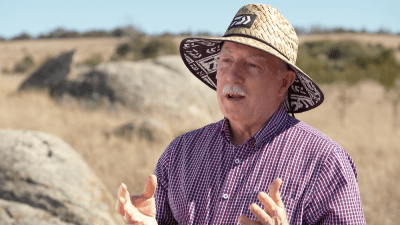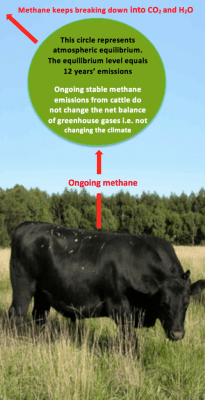IT has taken the work of prominent scientists such as Oxford University’s Dr Myles Allen to draw high level scientific attention to flaws in the way methane emissions from livestock are calculated.
But, as Dr Allen noted in a recent webinar, it also took the earlier work of a sheep and cattle producer from western Queensland, among others, to provide the groundwork needed to get there.
 Alan Lauder ran sheep and cattle at Cunnamulla and then Inglewood for more than 30 years. His deep level of interest in how livestock and plants interact with the carbon cycle led him to develop extensive networks within the scientific community.
Alan Lauder ran sheep and cattle at Cunnamulla and then Inglewood for more than 30 years. His deep level of interest in how livestock and plants interact with the carbon cycle led him to develop extensive networks within the scientific community.
His work to pull together a diverse range of scientific thinking led to the publication of the ‘Carbon Grazing’ principle in 2008.
As much as 20 years ago his work was drawing attention to the point that carbon ’flows’ through the landscape, while debate at the time was preoccupied with carbon ‘stocks’ which he said failed to recognise how a paddock actually functions and needs to be managed.
In 2010 Alan Lauder began publicly drawing direct attention to why stable methane emissions from cattle herds were not the climate problem they were depicted as in existing climate accounting methodology.
In fact, his in depth immersion into the science, tested with regular discussions with scientific experts in the field, showed that ongoing stable methane emissions from cattle do not change the climate.
This was because methane is a short term gas that keeps breaking down in the atmosphere, he explains. Stable ongoing methane from cattle leads to a stable balance of methane residing in the atmosphere, in a state of equilibrium.
Hence it is not changing the net balance of greenhouse gases in the atmosphere, or the net radiative forcing. This was described in this earlier article “Ongoing stable methane emissions from cattle doesn’t change the climate“.
It is a little known fact that the combined methane emissions of sheep and cattle in Australia peaked in the 1970s, when the national herd and flock peaked in size. The combined methane emissions from Australian sheep and cattle have basically remained stable ever since, with a slight decline.
Mr Lauder also developed a methane calculator to explain his thinking – as explained in this article in June 2010 – which triggered a peer-reviewed paper published in 2012, written by some of Australia’s top atmospheric scientists.
It is also important to note that even earlier, two states away and in isolation from Mr Lauder, another Australian, a climate scientist working at the University of Adelaide named Dr Tom Wigley, produced a paper discussing a similar concept of called the Forcing Equivalent Index in 1998, but which received little ‘air play’ in the climate science community which was pre-occupied at the time with the ’cumulative CO2 carbon’ budget concept, which remains the global convention today.
It has taken more than a decade for the concept of methane flows versus stocks, biogenic cycles and stable emissions from cattle herds that are not growing in size to gain attention in the international scientific debate on livestock emissions and global warming, which has occurred in recent years largely due to the work of high-level scientists such as Dr Myles Allen.
This thinking is now captured in the “Global Warming Potential Star’ approach to accounting for the warming impact of short and long-term climate gases, as opposed to the existing GWP 100 approach which treats the warming potential of all gases as equivalent.
GWP Star is not ‘new’ science: Dr Myles Allen
In a recent webinar Dr Allen, who has been instrumental in developing the Global Warming Potential star method, emphasised that while people tended to refer to GWP Star as “new”, the thinking behind it has been around for more than 20 years.
He noted that Alan Lauder, who also spoke on the same webinar panel, really “pre-figured” the work on GWP star, adding “I am delighted to meet him”.
He further explained that thinking around the concept went back even further to a paper by Tom Wigley in 1998.
“He introduced the idea of a forcing equivalent index which is really very similar to the idea of GWP star.
“I emphasise this because a lot of those who would rather not think about this are quite keen to say ‘oh, it is a new-fangled idea, don’t worry about it’.
“So I do like to emphasise this is not particularly novel science I am talking to you about today, but some of the implications for climate policy are quite profound.”
Dr Myles said the crucial point he wanted to explain was that the standard CO2 equivalent approach of treating all gases as like some form of CO2 is simply “not fit for purpose” when dealing with policies aiming for a global temperature goal.
“We don’t actually need to give up eating meat to stabilise global temperatures,” Dr Allen explained in this 2018 article on The Conversation – Why methane should be treated differently compared to long-lived greenhouse gases.
 But whether these messages have come too late to influence global climate policy is now a key question.
But whether these messages have come too late to influence global climate policy is now a key question.
The EU is currently deciding its future methane policy. As reported yesterday, scientists such as Dr Allen are urging policy makers to switch from GWP 100 to GWP Star as the primary method of accounting for the warming potential of different gases.
However, as other scientists have pointed out, the existing GWP 100 convention is now deeply entrenched in global climate science policy and programs.
In the early days of publishing and communicating his research Alan Lauder struggled with persistent attempts to convince red meat industry bodies in Australia to get behind the science he was advocating, which was showing ruminants were not the global warming villains they were being cast as.
A decade later an urgent push is now underway to get such science validated, but years lost through lack of action mean the industry is now fighting a steeper uphill battle to convince global policy makers to take this science on board.


